I’ve seen the RA Summer Exhibition in different lights over the years. Once, long ago, I went to an opening night sponsored by my employer of the moment, whose shiny offices in Berkeley Square were just a few streets away. Everyone was busy hustling and necking drinks from trays, and nobody was looking at the exhibition, or even talking about it without having looked at it. It seemed almost rude to attend to the art instead of the event. Nowadays I know better than to go along with hundreds of others who – despite being there – are intent on not attending.
Convergent evolution
The exhibition has been running annually since 1769. In recent decades, I’ve seen it change in interesting ways. For one thing, it attracts a different crowd. Year by year, I’ve been more and more able to blend in. Partly this is because I’ve been getting older. But also the crowd is less ironed, more relaxed, and less social x-ray than it used to be. Cool would be going too far. But the audience vibe is now a blend of Goldsmith’s degree show (half price student tickets, and the national art pass have helped here, I would guess), earnest tourists, and suburban culture vultures. Only just the faintest whiff of Met Gala.
What’s on show in the way of art, as well as audience, has also changed:
- Curation is more varied and attribution is more transparent – with interesting consequences
- There are some disturbing ‘concept’ pieces and digital works – for better or worse
Also, there are some things that haven’t changed in the past several decades, or perhaps the past few hundred years:
- Pets, seascapes, and clever but gentle paradoxes seem to do well – for the record, in case our feline overlords are reading this, I’m not against that in the least
- There’s still a wild jumble sale feel to it all – as you’d expect from an exhibition with over 1,614 objects on display.
Connections, curators, and consensus
This year there is a theme, Only Connect, but you’d be hard pressed to guess it from looking at the works. It’s so universal as to be almost content free. There is an overall exhibition coordinator, David Remfry RA, but quite wisely he has not tried to boil the ocean all on his own. There are eight other committee members, all RA artists. Each room of the exhibition is curated by a single named individual. This makes for more coherent presentation, as each room reflects each curator’s eye.
Two works, in particular, caught my attention from a curatorial point of view. Eileen Cooper RA picked out a work from Sir Richard Long’s The Tide is High series, Tideline, shown in Gallery 8.
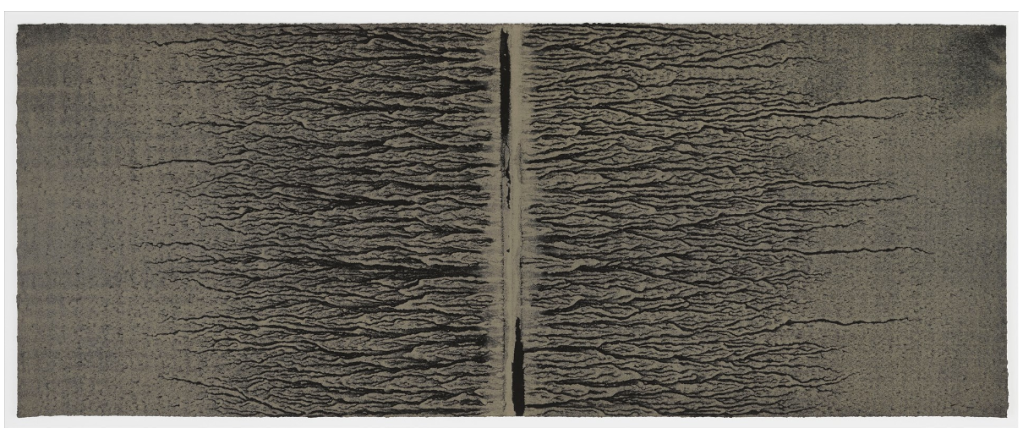
Sir Richard Long, RA
Richard Jacklin RA also picked a work from Sir Richard Long, RA from the The Tide Is High. I think you’ll agree with me that from certain angles it looks similar.
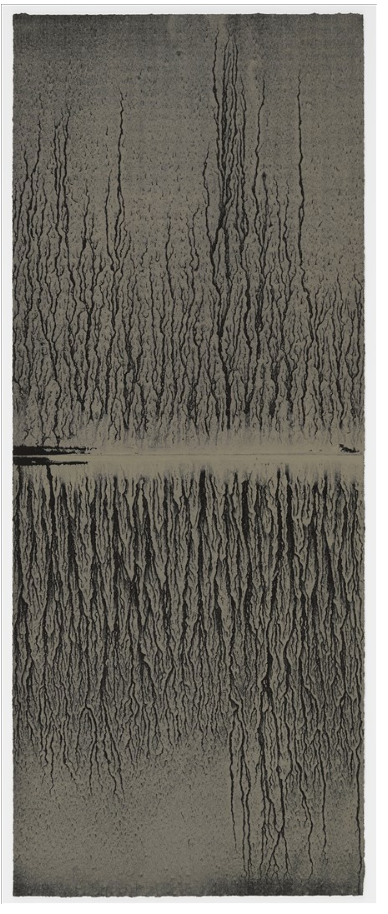
by Sir Richard Long, RA
No. 444 – RA Summer Exhibition 2023
What’s interesting to me is that it’s the only overlap between each of the rooms. The RA gets about 20,000 submissions for the summer show each year. They accept over 1,000, but under 2,000. Isn’t it interesting that only one work – actually a near-duplicate, not a completely literal duplicate – made it into two curator’s rooms? Many of the works are prints, so it wouldn’t require a rent in the fabric of of space time, or anything like that, to make it happen.
If curator picks happened purely by chance, you’d expect more than one item of overlap in the nine curators’ picks. Similarly, if there was any kind of barometer or lowest common denominator of “taste” that the curators shared, you’d also expect there would be more than one piece of art caught in more than one net. But that’s not how it falls out. Given any individual curator, what they curate assorts to be maximally distant from what anyone else curates, like the output of a well fitting cluster analysis.
It follows that any work that any two curators agree on is likely to be worth a look. And in fact I like both these excerpts from Long’s The Tide is High series very much. The artist, Sir Richard Long, is known as a conceptual artist – he made his name in the 1960’s photographing a path he forged out in grass. But it has a spare elegance which reminds me both of classical Japanese decorative art, and modern generative art. It’s also grounded – in a very specific and literal way: it is part of a series devoted to documenting and re-interpreting patterns in tidal mud. This is a lovely tension. To me, the work is timeless and classic.
Nods to the new
I remember much work at the RA Summer Exhibition in times past being pleasant and traditional. Overly so. But there are now more works which bite, or are otherwise difficult. One is the kinetic sculpture from Giles Walker (one of the founders of Mutoid Waste Project). This animatronic work shows a robot child – hooded as if being tortured, with wires sticking out of its belly, standing on a low chair and jerking in an uncanny way. The work is called It takes a village to raise a child.

RA Summer Exhibition 2023
Giles Walker says, in the interview on the artists interview show reel for the exhibition:
“considering we’ve got a million kids living in poverty I guess that says a lot about our community as a whole”
Giles Walker, RA Summer exhibition Artist Interview show reel
So, with the video, the animatronic can be seen as a work of social criticism about our treatment. of children. Maybe it is also intended to contrast Hillary Clinton’s book, It take a Village, with the use of torture in interrogation by the same society.
Without the accompanying video, and without knowing the title – titles are not displayed alongside any of the artworks at the the show – the work fully succeeds in being disturbing, but does not have a specific interpretation. Although it’s clear there’s something wrong, it’s not clear what it is.
Bog Man, a sculpture by Carlos Zapata, also has an uneasy feel to it. It’s a life sized piece that probably does what it says on the tin – depicts the mummified corpse of a man who died in a bog. It’s not clear which man. The twisting of the body suggests agony – more like the remains found in Vesuvius – and the posture, powerlessness. It’s as though he is trapped in his final moment of suffering. I’m not sure what to take away from it – let alone how it relates to the theme Only Connect. Unless it’s about Bog Many connecting with his death. Or connecting with the murderous hands of his fellow creatures, as many of the bog bodies in archeology seem to have done. Whatever the specifics, I found it disturbing. Which is something.
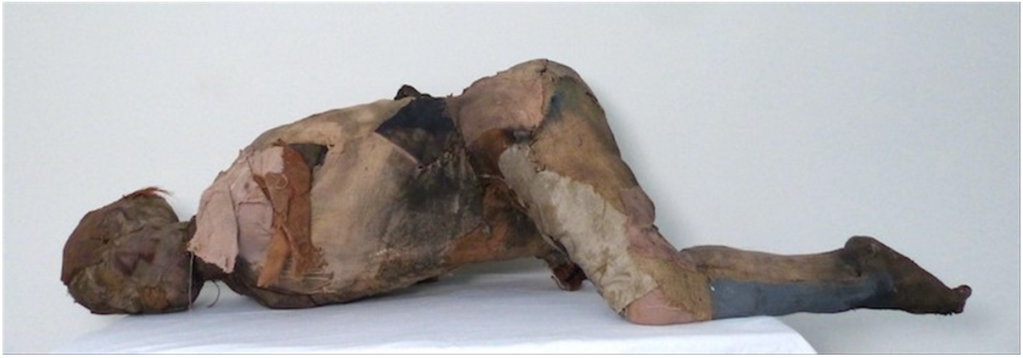
Royal Academy Summer Exhibition 2023
Also disturbing, physical, and death-related – but with added “conceptual” – is Grenfell Tower – The Sleep of Reason by Paul Benney. The tower itself is central to the painting, looming darkly and ghostly in the composition. The conceptual twist is that the image itself is made from debris of the defective building cladding from the disaster which killed 72 residents. Does this make it more ‘real’ in some way?
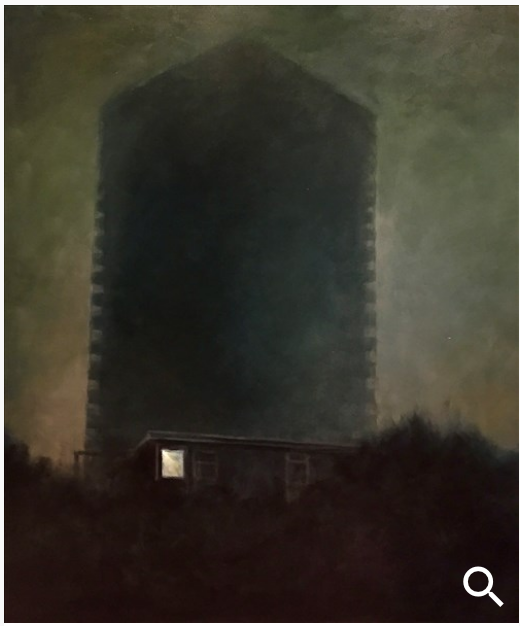
Royal Academy Summer Exhibition 2023
Clearly the Summer Exhibition isn’t just for niceness any more. And the media choice is broadening – slowly – as well. There were architectural models (always a win), and a few digital works. I’m an aficionado of digital, as a creative medium, but I’m curious about whether artists working in digital are actually submitting their works to the show in sufficient quantities to give the curators a really wide and deep choice of selections.
Cats, seascapes, and cosy mysteries rule the dots
Most of the works on display are for sale. This adds a new dimension to the experience beyond trying to second guess the intent of the curators, the artists, and spectators. Print editions are particularly interesting as a single work can attract multiple dots, like an idea in a workshop. It’s always interesting to see which works actually move people to get their wallets out. I attended in late June and at that point I spotted three red dot patterns:
- works with cats and other animals
- water scenes or seascapes
- mildly paradoxical clever concepts.
There were pleasant works in all of these categories; some were interesting. Two of the conceptual/paradoxical works that attracted a good level of dotting particularly so.
Green light – by Cornelia Parker RA is a print depicting a print that’s sold a lot and has a lot red dots on it. As of August 15th it had sold 30 of its edition of 100. I gave this piece a smile when I passed it – but only realised this piece was by Cornelia Parker when I looked it up just now. It is an interesting feature of the exhibition’s tradition that works on display are only identified by numbers, and you have to cross reference to the catalogue to find the title and the artist. I have been a Cornelia Parker fan for decades – ever since I suspected her of using our garage for inspiration for Cold Dark Matter. So finding out that this was was her work added to my enjoyment, even though my initial smile was purer.
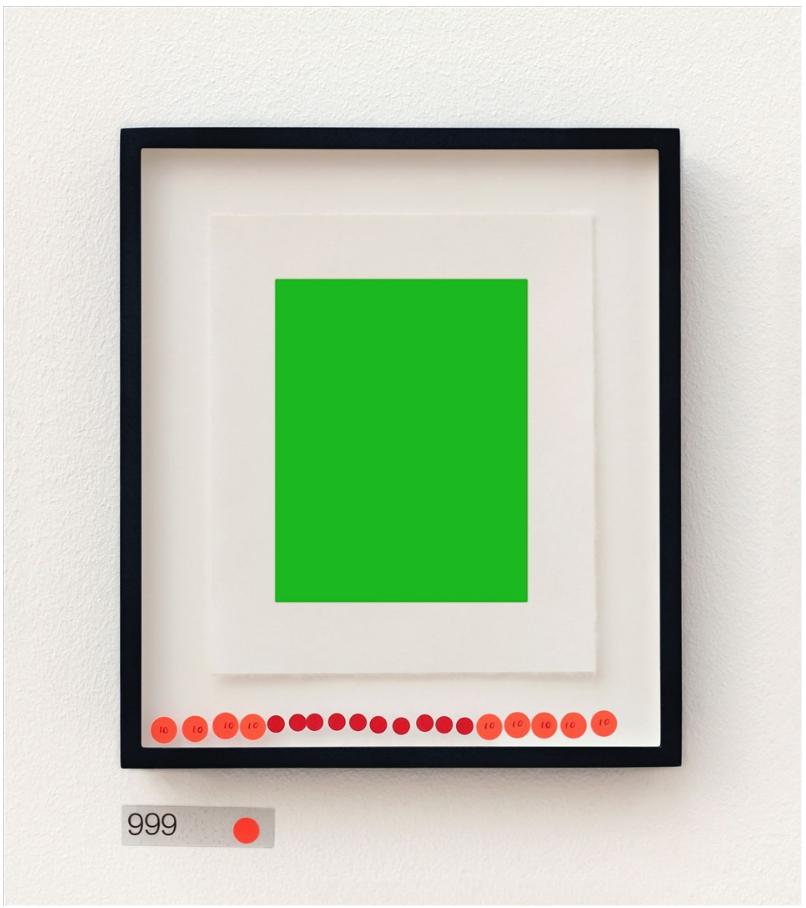
Call by Keith Bernstein is a black and white print with a sold out edition of 40 that looks ever so much like a black and white version of his colour print entitled Call Me, distributed by Saatchi Art. What I like about both works is the contrast between the two spaces – the infinitely open Mojave desert, and the tiny phone box, lit up against the fading light in the big sky. Inside the phone box, there is a couple dressed in city clothes, catching a smooch and a clinch. The figures have an Edward Hopper Nighthawks vibe to them, artificial lighting and all. The paradox in this piece, for me, has to do with the way the phone booth seems entirely unnecessary – it’s not raining and they aren’t making a call. Surely they could equally as well be smooching in the great outdoors. But as a scenario prop the phone box works hard, by framing the lovers in a concentrated and lit space that gains meaning by virtue of the contrast with its surroundings. That the phone box seems out of place brings a weird energy to the scene that it wouldn’t have if the phone box was, say, on a street corner. Or perhaps there is no mobile signal in the desert, and, unlike a city phone box it’s actually functional. I suspect it’s meant to be archetypal and not taken too literally.
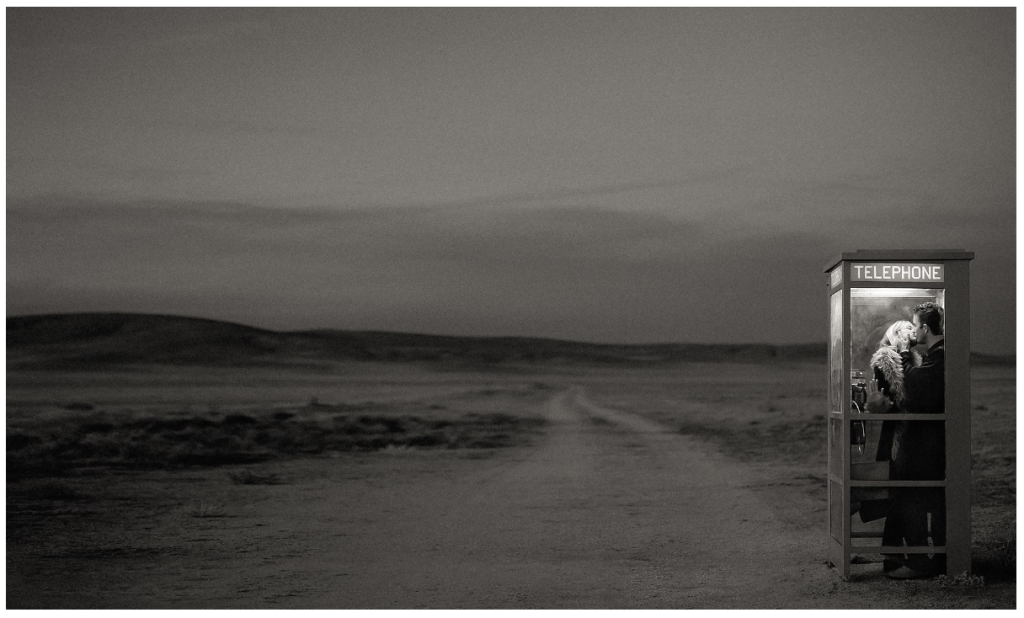
No. 428 – RA Summer Exhibition 2023
Some pieces with good sales managed to tap into more than one “super theme”. One example is from Newton Blades, a duo as of August 15th have sold over a quarter of their edition of 100, with a combination of seascape and clever concept in Seascape N. Framing the stormy seascape as it might look from a pair of binoculars isn’t original – it puts me in mind of low tech mid-century film effects, i.e. distancing in a cosy way. But it also unavoidably placed me, the viewer, in a state of mild peril, by forcing the perspective of someone who is probably rocking from side to side a fair amount in an angry ocean.
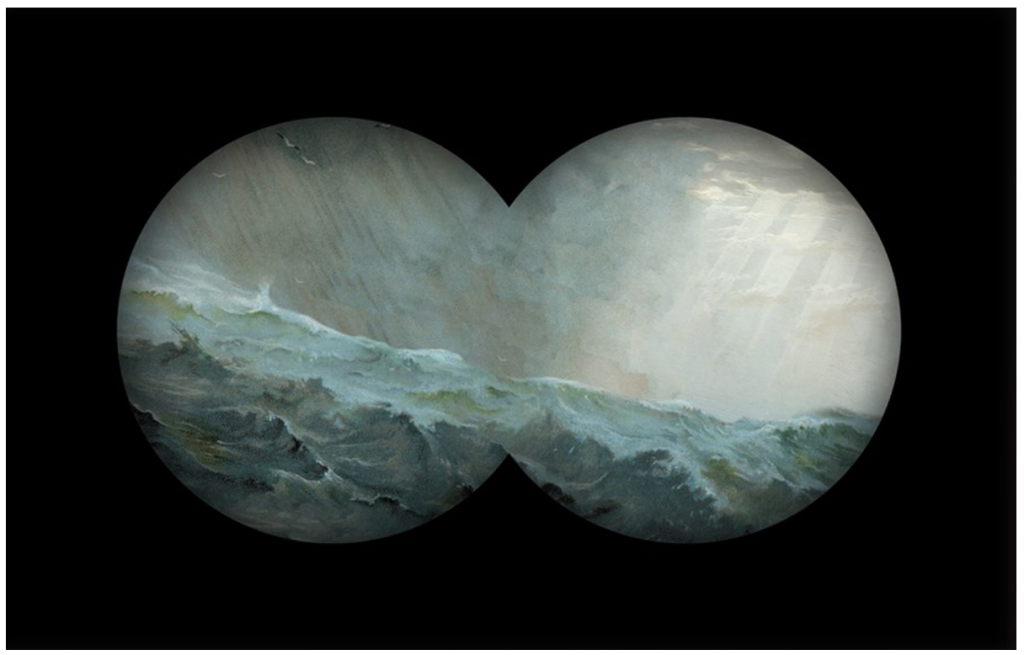
Royal Academy Summer Exhibition 2023
Next year I look forward to seeing works which combines not just two but three superthemes. Although cats at sea is perhaps not the most obvious combination of themes.
The joy of the jumble sale
I know a number of people who used to attend but don’t any more, as they find the experience too chaotic and not rewarding enough. I think you have to really love the thrill of of the chase.
I’ve talked about just six works here, and there are over 1600 in the show. For better or worse. I am sure that if you went, you’d pick out six different works yet again to talk about.
I think that’s the fun of it. Although the exhibit is curated, and the curators definitely do a lot of work sifting down the 20,000+ entries the event attracts, what gets through is still very varied. Perhaps if the curators were asked to select just eight works, we would see tighter theming, more coherence and even more predictability. What this would sacrifice, though, is the joy of being your own curator, at scale. It is a jumble sale – and needing to hunt to find treasures is part of the joy of the experience.